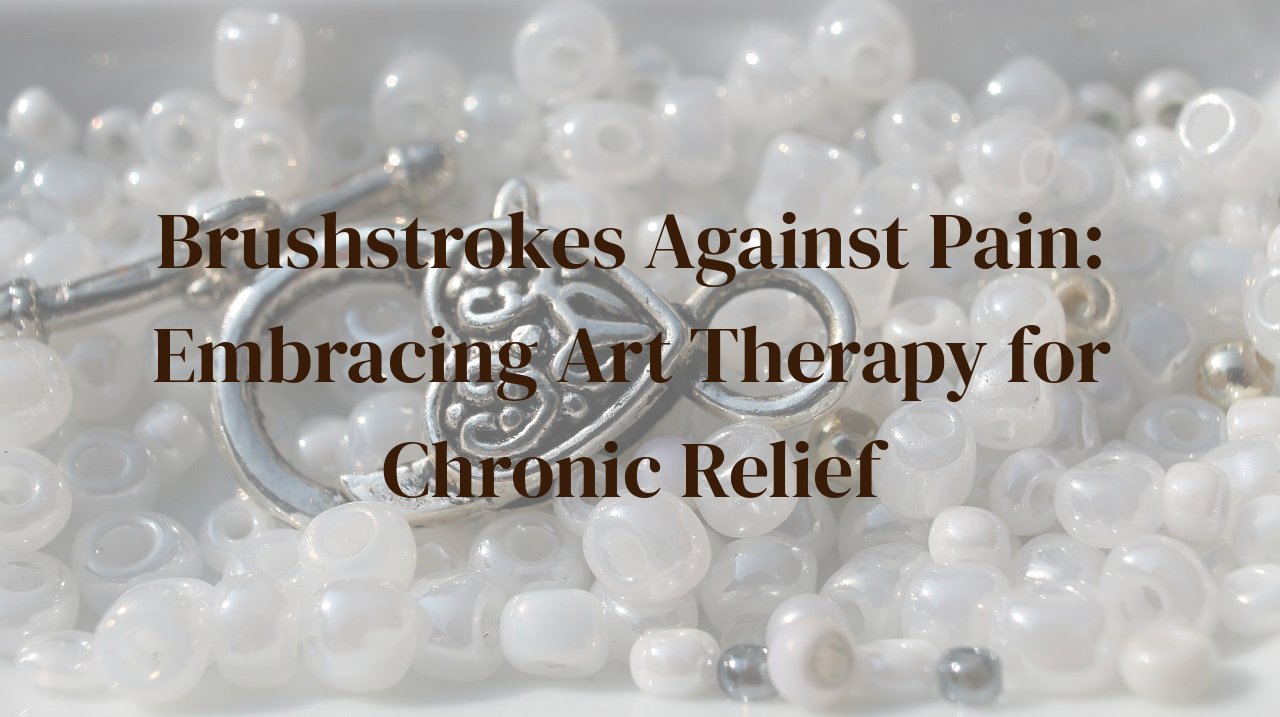
As the brush moves across the canvas, each stroke may not only paint a picture but also trace paths to managing chronic discomfort. This post delves into the transformative power of art therapy as a companion to conventional chronic pain care. By exploring the enigmatic ways art engages our mind and body, I’ll highlight innovative strategies for those seeking solace from persistent pain. Readers will gain insights into integrating creativity into their healing journey and uncover the potential benefits art therapy may offer for long-term wellness.
Table of Contents
Exploring the Basics of Art Therapy and Pain Management
Delving into the fabric of art therapy as a viable provision for managing chronic pain, my journey began with a backdrop of skepticism and a canvas of quiet curiosity. I discovered that at its core, art therapy is an amalgamation of psychotherapy and visual arts, aimed at fostering expression, understanding, and healing. There is something undeniably therapeutic about the strokes of a brush, the blend of colors, and the abstraction of form that speaks to our innermost struggles, including pain.
In the landscape of pain management, art therapy often takes on a gentle role, softly inviting the individual to converse with their pain through mediums such as painting, drawing, collage, or sculpture. It may seem elusive at first- how can creating art mitigate something as tangible as physical pain? Yet, it’s not just about distraction, but rather articulation and externalization. With chronic pain, there can be an attendant burden of emotional distress – art therapy provides a conduit for releasing that weight.
It is about building a dialogue between the mind and body, where cognitive-emotional barriers to pain management are lowered, and a patient is encouraged to personify their pain on canvas or paper. This personification is more than an exercise – it’s a form of acknowledgement and confrontation. By externalizing pain, patients can often find a measure of control and understanding. The simple act of creation brings forth a mindful state akin to meditation, which has been shown to help in coping with chronic pain by modifying pain perception and response.
The journey within art therapy can be both profoundly personal and inexplicably shared. As a blogger who has interacted with numerous chronic pain warriors, I have seen art therapy not only as an ally in pain relief but also a kindred spirit in resilience. There is a palette of experiences that can be blended into an individual’s healing process, each color representative of a step towards reclaiming the joy obscured by unyielding pain.
Thus, exploring the basics of art therapy teaches us that pain may never fully vanish, but the narrative we weave around our pain can change profoundly. In the landscape of chronic pain management, the paintbrush might seem incongruous, yet it is a powerful implement, capable of crafting not just images, but hope, restoration, and a renewed sense of self.
The Healing Palette: Art Therapy Techniques and Exercises
Art therapy is not just a form of self-expression but also a therapeutic tool that can provide immense relief for those battling the persistent tribulations of chronic pain. The hues and strokes of art offer a gentle respite from the sharp realities of pain. In my years of exploring the interplay between art and healing, I have witnessed firsthand the transformative power of the healing palette.
One of the most accessible techniques is ‘free drawing,’ where individuals are encouraged to let their emotions flow onto paper without judgment. This process can unlock emotional blockages and foster a sense of calm. ‘Coloring Mandalas’ is another exercise that promotes relaxation and mindfulness, providing a much-needed distraction from discomfort. The repetitive action of coloring intricate patterns can help reduce anxiety, which often accompanies chronic pain.
‘Sculpting’ requires tactile engagement, and the physicality of molding materials like clay can be both grounding and cathartic. It’s remarkable how crafting a three-dimensional form can offer patients a tangible way to externalize and manage their pain. ‘Collage making’ also emerges as a powerful way to visualize one’s journey with pain and healing. By combining different elements, textures, and images, individuals can map out their internal landscapes, creating an insightful narrative of their experiences.
Lastly, ‘guided imagery drawing’ is an exercise where patients are led through a peaceful visualization before they create art that represents that serene space. This practice connects the unconscious mind with a physical activity, often leading to profound insights and a deep sense of peace.
While nurturing others through these techniques, I’ve grown too. I’ve observed glimmers of relief on faces strained from pain and have seen how a single brushstroke can speak volumes of a person’s unspoken struggles.
Personal Testimonies: Stories of Art Assisting in Pain Alleviation
Through the vibrant strokes of a brush, the gentle kneading of clay, or the delicate dance of a pencil on paper, countless individuals have found solace and reprieve from the relentless presence of chronic pain. Personal testimonies offer a window into the transformative power of art therapy, showcasing how creative expression can become a powerful ally in the management of persistent pain conditions.
Consider the story of Emily, who, after a car accident, faced the formidable adversary of chronic back pain. Standard pain management strategies brought little relief, but when introduced to art therapy, Emily uncovered an unexpected source of comfort. She revealed that ‘focusing on the colors and forms in my paintings, I drifted away from my pain. It didn’t cure me, but it gave me moments of escape that were invaluable.’
Then there’s Michael, a veteran who struggled with post-traumatic stress disorder and the accompanying chronic pain. For him, art therapy sessions were a revelation. Sculpting became his outlet, allowing him to mold his anxieties and pain into something tangible. ‘With every piece of clay I shaped,’ he recounted, ‘it was as if I was releasing a piece of my pain into the art. It helped me communicate what words couldn’t.’
The narrative of Ana also stands as a testament to the potency of art in pain alleviation. Living with fibromyalgia, she found respite by crafting intricate mandalas. ‘The act of creating symmetrical designs centered my mind and eased the widespread pain,’ Ana expressed. ‘In those moments, the mandalas became my meditation and my medicine. The distraction and focus on detail were more effective than any painkiller.’
Each of these stories amplifies the notion that art therapy can be a gentle yet potent tool in the quest for chronic pain relief. While diverse in their mediums and experiences, individuals like Emily, Michael, and Ana, illustrate the common thread of finding a therapeutic release, a sense of control, and a voice through their art. What emerges is not just a portrait of pain, but a gallery of resilience and hope painted with the broad, healing strokes of artistic endeavor.
Integrating Art Therapy into Your Chronic Pain Care Plan
Living with chronic pain often feels like a relentless battle, but incorporating art therapy into your care strategy can offer a respite, nurturing both mind and body. As someone who has experienced the visceral grip of chronic discomfort, I’ve found solace and strength in the expressive powers of art. Embarking on this artistic journey toward pain management is a step toward reclaiming control and vibrancy in life.
The first stroke in integrating art therapy is consulting with your healthcare provider to ensure it complements your existing treatment regimen. Once you have their endorsement, seek a certified art therapist. These professionals are trained to tailor activities to your specific emotional and physical needs, setting the canvas for an effective therapeutic experience.
Start small and non-intimidating. A personal art therapy plan doesn’t require you to be a master artist; it’s about the process, not the end product. Try engaging in simple coloring books or free-drawing sessions, activities proven to reduce stress and distract from pain. As you grow comfortable, expand to mediums like clay modeling or watercolor painting, which provide tactile stimulation and a calming focus for the mind.
Setting a regular schedule for art therapy is crucial, as consistency aids in establishing a sense of routine and normalcy. Even short, 20-minute sessions several times a week can make a significant difference in managing your pain. Keeping a visual journal can document your journey, and over time, you’ll be able to reflect on your progress and communicate your experience more eloquently.
Merging this artistic approach with other pain management techniques, such as mindfulness and deep-breathing exercises, can heighten the effects. During an art session, practicing mindfulness can help you become fully engaged in the moment, potentially lowering the volume on pain signals and enhancing relaxation.
Lastly, don’t overlook the power of community. Joining an art therapy group or workshop provides social support and motivation. Sharing your artwork and experiences with peers can foster a collective healing environment filled with empathy and understanding—a true embodiment of the phrase ‘strength in numbers.’
In conclusion, weaving art therapy into the fabric of your chronic pain management is not a one-size-fits-all approach, but with patience and creativity, it can illuminate paths to comfort and self-expression that you may have never imagined possible.
Research and Reflections: The Efficacy of Art Therapy in Pain Treatment
The burgeoning field of art therapy has recently captured the attention of the medical community for its potential in managing chronic pain. As someone deeply entrenched in this area, I’ve witnessed both through research and personal observations the transformative power it holds. Countless studies have elucidated the mechanisms behind art therapy’s efficacy, revealing a fascinating intersection between neurophysiology, psychology, and creative expression.
A study I hold in high regard, published in the Journal of Pain Management, demonstrated that engaging in art therapy activities significantly reduced pain perception in participants with fibromyalgia. The act of creation provided a distraction from their discomfort, effectively reducing their pain’s intensity and frequency. This research paves the way for non-pharmacological interventions in the domain of chronic pain, a domain all too often saturated with medication dependency.
I’ve also reviewed compelling meta-analyses that indicate a consistent trend: individuals embracing art therapy report improvements in pain-related anxiety and depression. This enlightens us about art’s dual function—it’s not only a tool for symbolic expression but also a conduit for altering one’s emotional landscape, thereby reducing the cognitive load pain can levy.
Moreover, neuro-imaging studies have unearthed art therapy’s capacity to activate brain regions associated with positive emotions and stress relief. This furthers the dialogue on art therapy as a mediator of pain by reshaping brain activity. Engaging in art has the potential to create a ‘neural detour’ around chronic pain pathways, offering relief where conventional approaches may falter.
But beyond the data and the peer-reviewed articles is the living testament of individuals. I’ve had the privilege of interviewing several chronic pain sufferers who’ve woven art therapy into the tapestry of their pain management. Their voices echo a common sentiment: art therapy furnishes a sense of control, ownership, and creativity that is often stripped away by the persistent nature of chronic pain.
In conclusion, the synergy of clinical evidence and lived experiences builds a compelling case for art therapy as an effective ally in the quest for chronic pain relief. While more research is necessary to fully understand its potential, the current evidence stands as a beacon of hope, signaling towards a future where pain management might be as much about brushstrokes as it is about pill bottles.
Conclusion
In closing, the intersection of art therapy and chronic pain management is more than a fleeting trend; it’s a testament to the resilience of the human spirit and the therapeutic potential of creative expression. Whether you’re a patient, caregiver, or healthcare professional, embracing the nuanced art of healing can offer a valuable addition to your pain management toolkit. The journey to respite from chronic pain can be arduous, but with art therapy, there’s hope for a canvas filled with brighter, less painful days.



